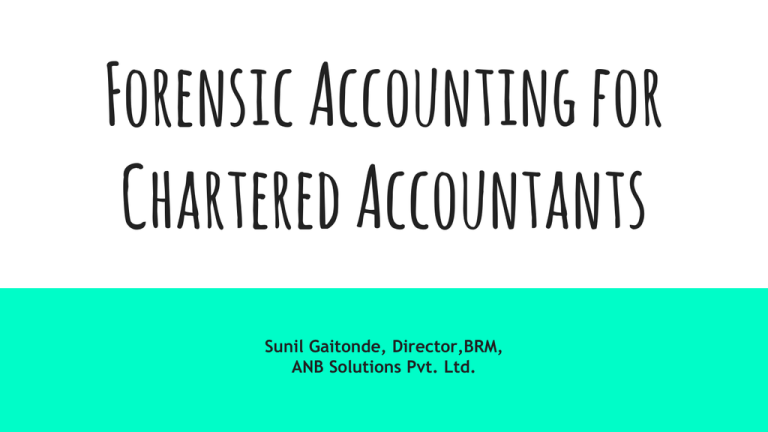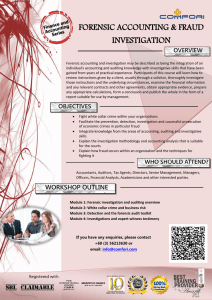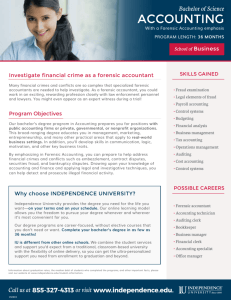Forensic Accounting for Chartered Accountants Sunil Gaitonde, Director,BRM, ANB Solutions Pvt. Ltd.
advertisement

Forensic Accounting for Chartered Accountants Sunil Gaitonde, Director,BRM, ANB Solutions Pvt. Ltd. fraud? We, the Chartered Accountants, normally have to deal with white collar crime i.e. fraud, which has a financial implication. Fraud encompasses activities involving dishonesty and deception that drain value from a business. Frauds may be classified as those that are against an organization, also referred to as “Asset Theft Frauds” or those that are by the organization, also referred to as “Financial Statement Frauds” Fraud Defined The Association of Certified Fraud Examiners (ACFE) defines fraud as “Use of one’s occupation for personal enrichment through the deliberate misuse or misapplication of the employing organization’s resources or assets. Fraud, particularly the white collared crime encompassses a wide range of intentional acts, leading to any kind of damage to an organization. OMG! never heard of frauds? Is fraud a new age phenomena? Arising out of our lifestyle? If that was the case, there was no need for Kautilya to identify and mention as many as 40 ways of embezzlement. These include, Incurring expenses for jobs not carried out at all; Execution of unnecessary jobs; Excessive payments; Payment to a person other than the one to whom it is to be made; Replacing a high value object with a low value one; Non delivery of products, services for which payments have been made etc. DNA of fraud A Fraud is basically a mindgame. It is born in the delta of “Opportunity”, Need (Greed) and Justification. Opportunity Justification Need A fertile delta may give rise to more frauds. Hence bigger companies appear to be more fraud prone than the smaller ones. I am clean but…. Opportunity is the mother of all frauds. If there is no opportunity, there will be no fraud. Need or Greed are in a way interchangeable terms. Something starting as a need ends up as a greed or vice versa. Justification or Rationalization is the process of swallowing the wrongdoing by picking up examples from the people around. Can you arrange the above in a sequential order? Impossible. Hey… it was just an error Errors are a result of inefficiency, oversight etc. whereas fraud is a handiwork of shrewd and efficient planning. Errors are those that are inadvertently committed without any intention of concealment whereas frauds are deliberately and intelligently committed. In short, Errors are unintentional whereas frauds are intentional.As a result, errors are normally easy to detect whereas fraud detection is an expert’s job. But… i get my accounts audited Sorry guys. You need to be a Forensic Accountant in order to be “that” expert. Audit (in the corporate context) is mandatory, concentrates on compliance with accounting standards and gives a reasonable assurance that the financial statements are free of material misstatements. Forensic Accounting on the other hand happens more as a response to an event, it implies financial investigation and its findings are used as “evidence” in the court of law. But we both are human beings... Forensic Accountants look beyond numbers. Their role model is Sherlock Holmes. They are the key to beating the bad guys. Webster’s dictionary defines Forensic Accounting as “belonging to, used in or suitable to courts of judicature or to public discussion and debate”. A Forensic Accountant has to establish the motive and the financial impact in order to make his findings stand the scrutiny in the court of law. What's to great yaar... Forensic Accounting is like solving a jigsaw puzzle. Unless all the pieces fit at right places, the picture will look incomplete, distorted and messy. You too can be good Forensic Accountants provided you have: A proactive and skeptical approach; Ability to tackle the issue without any assumptions; Curiosity, Persistence, common sense, ability to put people at ease and understanding of human nature. Is that all? Wait... Knowledge of accounting, auditing, internal controls, risk assessment, fraud detection and an understanding of the legal environment; Good communication skills - oral as well as written; Patience, analytical mindset; Grasp of the substance of the situation; Ability to think, observe, recall facts. Enough. Enough. Now tell us about your approach Complete understanding of the matter without any biases; Clarity of scope - Crystallize the objectives; Actual investigation - Evidence collection, field work; Strengthening of evidence - additional evidence, interviews; Establishing the onus; Establishment of motive; Figuring out the damages; Reporting. So much about evidence? Evidence is the most critical part of any Forensic Accounting. The entire case hinges upon evidence. Evidence may be direct or indirect. Direct evidence is available from the documents and interviews conducted during the course of investigation; Indirect evidence is a result of field work as well as use of tools like digital analysis. Confused? let’s then move to digital forensic Digital Forensic is the practice of determining past actions that have taken place on a computer system using computer forensic techniques and understanding artifacts. An artifact is a reproducible file, setting or system change that occurs every time an application or operating system performs a specific action eg. first time log-in by a user. Using forensic tools, one can recover deleted files, identify artifacts, view all files those hidden and perform analysis to determine what occurred on a system. Hows this done? Digital Forensic generally involves following steps: Collection of the data - Live or Dead; Imaging the media -Exact duplicate of the original evidence; Examination of the data - To check completeness; Analysis of the data - Keyword search, suspect information; Indexing the data - To make it presentable; Reporting - Unbiased findings based on the analysis. Help.. help..Any tools? The typical tools are: Audit Software - for data analysis; Mathematical Tools - Data Query Models for analysing trends; Statistical Tools - Benford’s Law for deviations from expected frequencies; Digital Tools - Computer Aided Auditing Techniques (CAAT). Before you guys throw me out... A BIG THANK YOU.



